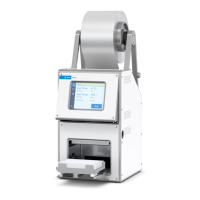PlateLoc Thermal Microplate Sealer
Frequently asked questions
12 Reference for Optimal Thermal Microplate Sealing
Microplate-sealing technology and automation
Q
We are overwhelmed by the technology choices currently available for sealing
microplates (thermal, adhesive, laser, cap mats, etc.). Is any one actually better
than the other?
A
The best choice is application- dependent. To determine whether a manual,
semi- automated, or automated approach would be cost- effective for your lab,
evaluate how many microplates you are sealing today and how this might
change over the next 12 months.
There are benefits to all sealing approaches. Each approach has strengths and
weaknesses that must be weighed against the cost and benefit to your specific
samples.
Thermal microplate sealing is a proven approach and is generally believed to
pose the least risk of chemical incompatibility (samples and seal material)
when compared to adhesive sealing. Thermal sealing subjects the top of the
microplates to a few degrees of heat transfer, but the heat is typically not
enough to affect most samples in life science applications. Thermal seals also
typically cost less than adhesive seals.
Adhesive microplate sealing employs pressure- sensitive adhesive films (PSAs)
and is most commonly used for thermally sensitive samples. Protein
crystallography and some cell biology applications are instances in which
customers most often use adhesive sealers.
Heat-sensitive samples
Q
We want to seal our microplates to safely store our samples, but our samples
are heat sensitive. A colleague suggested we consider adhesive sealing
technology. Exactly how much heat will our samples be exposed to if we use a
PlateLoc Sealer?
A
Most commonly, the PlateLoc Sealer is set to 130–170 °C for a duration of 1–2
seconds. Under these conditions, the temperature of the top of the microplate,
and possibly the sample, could increase a few degrees. However, this can vary
based on microplate material, microplate height, sample volume, etc. Agilent
Technologies recommends that you verify that the PlateLoc Sealer does not
adversely affect your samples.
Continuous (24/7) operation
Q
We intend to share our PlateLoc Sealer in a core lab. Is it OK to operate it
24/7?
A
The PlateLoc Sealer is robust and designed for challenging, high- throughput,
continuous- duty, production applications. We encourage you to use it for your
most demanding applications. We also encourage you to talk to other PlateLoc
Sealer customers, or consider an extended warranty.

